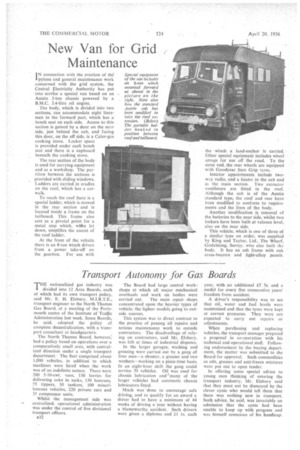Transport Autonomy for Gas Boards
Page 66

If you've noticed an error in this article please click here to report it so we can fix it.
THE nationalized gas industry was divided into 12 Area Boards, each of which had its own transport policy, said Mr. E. H. Elsbury, M.I.R.T.E., transport engineer to the North Thames Gas Board, at a meeting of the Portsmouth centre of the Institute of Traffic Administration last week. Some Boards, he said, adopted the policy a complete decentralization, with a transport consultant at headquarters.
The North Thames Board, however; had a policy based on operations over a comparatively small area, with centralized direction under a single transport department.The fleet comprised about 1,000 vehicles, in addition to which machines were hired when the work was of an indefinite nature. There were 200 5-10-cwt. vans, 150 lorries for delivering coke in sacks, 150 boxvans, 75 tippers, 50 tankers, 100 miscellaneous vehicles, 220 private cars and 35 compressor units.
Whilst the management side was centralized, operational administration was under the control of five divisional transport officers.
B32 The Board had large central workshops at which all major mechanical overhauls and work on bodies were
carried out. The main repair shops concentrated upon the heavier types of vehicle, the lighter models going to outside sources.
This system was in direct contrast to the practice of passing all repairs and serious maintenance work to outside contractors.. The disadvaritage of relying on contractors, said Mr. Elsbury, was felt at times of industrial disputes.
In the larger garages, washing and greasing were carried out by a gang of four men—a shunter, a greaser and two washers—working on a piece-time basis. In an eight-hour shift the gang could service 30 vehicles. Oil was used for chassis lubrication and 'many of the larger vehicles had automatic chassis lubricators fitted.
Much was done to encourage safe driving, and to qualify for an award a driver had to have a minimum of 44 weeks of driving a year without having a blameworthy accident. Such drivers were given a diploma and 1,1 Is. each year, with an additional £5 5s. and a medal for every five consecutive years' freedom from accident.
A driver's responsibility was to see that oil, water and fuel levels were maintained and that the tyres were kept at correct pressures. They were not expected .. to carry out repairs or adjustments.
When purchasing and replacing vehicles, the transport manager prepared a proposal in co-operation with his technical and operational staff. Following endorsement by the buying department, the matter was submitted to the Board for approval. Such commodities as oils, greases and anti-freeze mixtures were put out to open tender.
In offering some special advice toyoung men thinking of entering the transport industry, Mr. Elsbury said that they must not be dismayed by the clever cynic who would tell them that there was nothing new in transport. Such advice, he said, was invariably an admission that the cynic had been unable to keep up with progress and was himself conscious of his handicap.




















































































































